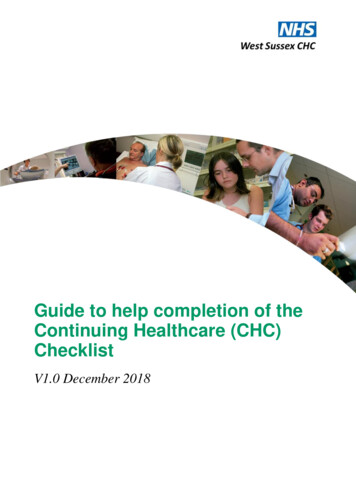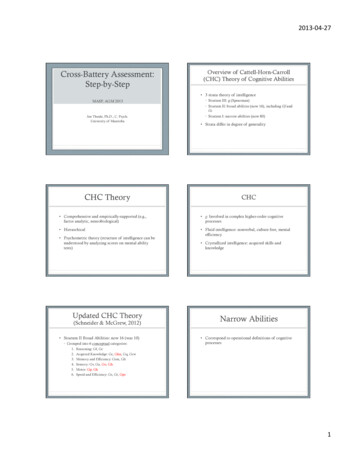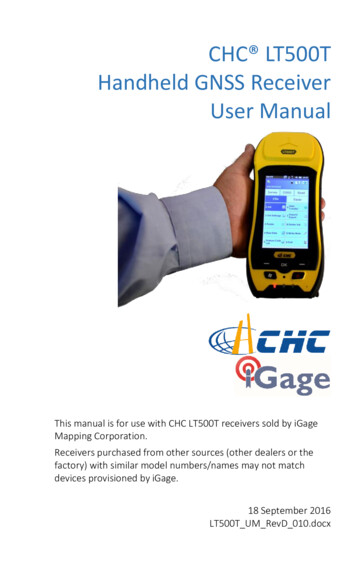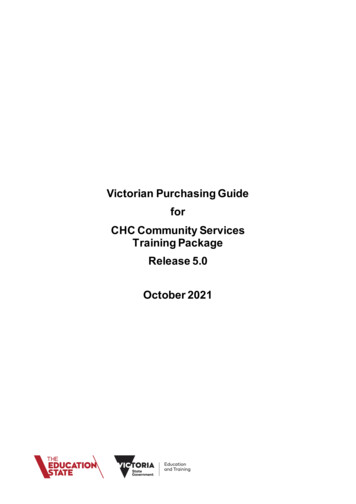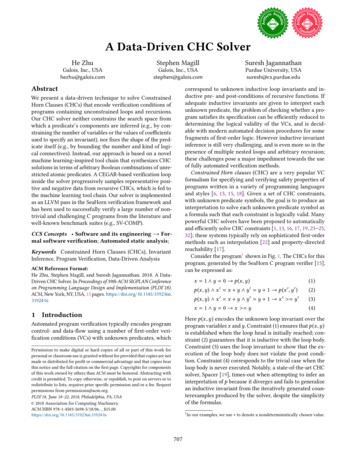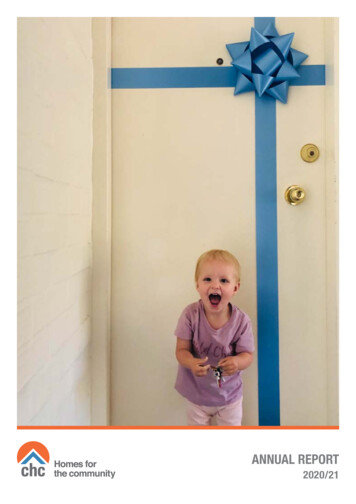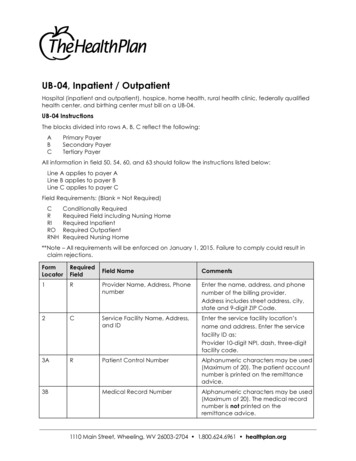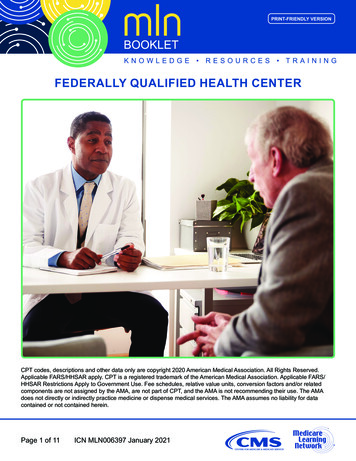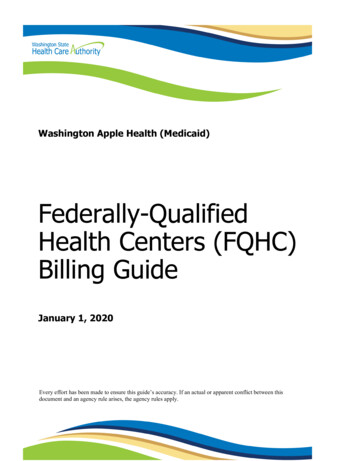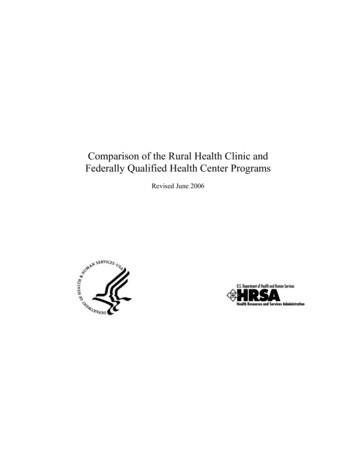
Transcription
2/25/2019CHC/FQHC & Hospital:Opportunities for StrategicRelationships & SynergiesPresented byFebruary 27, 2019To Receive CPE Credit› Individuals Participate in entire webinar Answer polls when they are provided› Groups Group leader is the person who registered & logged on to the webinar Answer polls when they are provided Complete group attendance form Group leader sign bottom of form Submit group attendance form to training@bkd.com within 24 hours of webinar› If all eligibility requirements are met, each participant will be emailed theirCPE certificate within 15 business days of webinar1
2/25/2019YourPanelistsJeff AllenPartnerjeallen@bkd.comDavid TaylorPartnerdtaylor@bkd.comJeff ’s Topics1Recognize collaborative opportunities between hospitals & CHCs thatcan create financial & quality strengths2Identify the grant reporting requirements specific to CHCs & recognize theireffect on any agreement with a hospital3Analyze the opportunities & challenges associated with both organizationsinvolved in the change of clinic ownership4Apply knowledge regarding other arrangements between CHCs/FQHCs &hospitals, including referral agreements, arrangements with hospitals forspecialist services on a session or similar basis & resident rotationagreements2
2/25/2019SuccessfulCollaborationsHospitals & CHC/FQHCs› Any collaboration needs to be a “win/win”to be successful long term› Financial due diligence is a must to helpensure that any additions or majorchanges do not put the overallorganization at financial risk› There is pressure to grow, but growwisely3
2/25/2019Collaboration ExamplesHospital transfersexisting outpatientclinic to an establishedFQHC/CHCHospital works withexternal communitygroup/organization toestablish a new FQHCor FQHC look-alike intheir communityHospital establishesan emergency roomdiversion programwith the local FQHCHospital enters intoother arrangementwith local FQHC(staffing, leasingarrangement, sharingresources, other)Relationship Opportunities withHospitals/Health Systems› Transferring hospital clinic to existing CHC/FQHC› Specialist arrangements› Resident rotation arrangements› Referral arrangements› Other hospital relationships4
2/25/2019Transferring Hospital Clinic to CHC/FQHC› Many hospitals operate outpatient clinics› Hospitals often operate these clinics to satisfy their charitable mission› Hospital clinics may not be operated as efficiently & cost effectively asCHC/FQHC sites› CHCs/FQHCs have a strong track record of offering quality, efficient care;through the right arrangement, can improve care to the community› CHCs/FQHCs should consider approaching hospitals to discusspossibility of the hospital transferring its outpatientclinics to the CHC/FQHCTransferring Hospital Clinic to CHC/FQHC› Potential benefits to CHC/FQHC New site Expanded operations Increase number of patients Less competition from hospital Can potentially lead to change of Medicaidrate (state-specific) Hospital can provide grant to CHC/FQHC to help offset losses5
2/25/2019Transferring Hospital Clinic to CHC/FQHC› Potential benefits to hospital Ability to limit its losses resulting from operating an outpatient clinic Can help ensure that its patients will still receive high-quality care Especially attractive for high-risk activities such as obstetrics› Hospital can provide grant to CHC/FQHC to help offset losses &help with hospital’s obligation to provide charity careTransferring Hospital Clinic to CHC/FQHC› Related considerations Need for state licensure/certificateof need approvals as applicable Space leasing considerations Construction considerations Timing› NAP application (if available)› HRSA change of scope6
2/25/2019Transferring Hospital Clinic to CHC/FQHC› Related considerations Staffing› Hiring new personnel› Hiring former hospital personnel› Temporary personnel leasing arrangement with hospital Credentialing providers Potential for specialist arrangements Potential for residency arrangementsTransferring Hospital Clinic to CHC/FQHC› Related considerations Notification to patients New Medicare number Notification to payors Determination of which services will be transferred & which will becovered by hospital Improved coordination with hospital for referred services &hospital/referral tracking7
2/25/2019Specialist ArrangementsDoes yourCHC/FQHC have ahard time findingspecialists?Explore an arrangement with ahospital to provide specialistservices on a session or similarbasisExplore an arrangement with aprivate practiceSpecialist Arrangements› Benefit to CHC/FQHC Patients can receive services that they would otherwise beunable to easily receive Furthers CHC/FQHC mission of providing care for totality ofpatient Ability to bill for E&M type visits at CHC/FQHC rates Can potentially lead to change of Medicaid rate (statespecific)8
2/25/2019Specialist Arrangements› Benefit to hospital Hospital avoids having patients who can be seen at CHC/FQHC showup at hospital on unscheduled basis, e.g., emergency room Helps hospital avoid unnecessary/avoidable hospital visits that aremuch more costly to the hospital & the patient While E&M visits at the CHC/FQHC take place at CHC/FQHC, testing& more intensive services continue to be performed at the hospital Specialists that typically do not see Medicaid patients in their privateoffices could consider seeing Medicaid patients at the CHC/FQHCSpecialist Arrangements› Related considerations Need for state licensure/certificate of needapprovals as applicable HRSA change of scope Pricing for these arrangements can be flexible› Session basis› Patient basis These relationships can fit in FQHC safe harbor9
2/25/2019Specialist Arrangements› Related considerations If the hospital credentials the specialists, the CHC/FQHC may not needto credential them Can give priority for these services to CHC/FQHC primary care patients Notification to payors “Value-based” potentialResident Rotation Arrangements› Benefit to CHC/FQHC Residents can be a good source of “free” labor Good recruiting tool› CHC/FQHC can recruit residents to work at CHC/FQHC followingcompletion of residency based on experience at CHC/FQHC› National Health Services Corps loan forgiveness programs› Visa candidates10
2/25/2019Resident Rotation Arrangements› Benefit to CHC/FQHC Primary care exception – allows one physician to supervise up to fourresidents at a time so four patients can be seen simultaneously undersupervision of one physician Hospital can provide its preceptors to supervise residents atCHC/FQHC under “leased employee” or similar model with potential forflexible pricing Potential for grant from hospitalResident Rotation Arrangements› Benefit to hospital Hospital can have its residents receive hands-on experience at primary caresite CHCs/FQHCs focus on totality of patient care which is important for residents Primary care exception – allows one physician to supervise up to fourresidents at a time so four patients can be seen simultaneously undersupervision of one physician Hospital can continue to have its preceptors oversee the residents to helpensure compliance with GME requirements under “leased employee” orsimilar model with potential for flexible pricing Hospital continues to receive GME funding for time residents spend atCHC/FQHC11
2/25/2019Resident Rotation Arrangements› Related considerations CHC/FQHC needs to determine time frame for residency programs, e.g., only certaindays or sessions CHC/FQHC needs to determine specialties it will allow for residents CHC/FQHC needs to determine limit on number of residents CHC/FQHC needs to determine if it will have its clinicians supervise the residents orhave the hospital preceptors supervise the residents Consider effect on Medicaid productivity rates (state-specific) Need residency rotation agreement Need agreement relating to supervision of the residents Right for CHC/FQHC to remove residents if potential for patient harmCHC/FQHC Requirements: HRSA Form 5A› CHCs/FQHCs must provide either directly or through contract or referral arrangement All required primary & preventive services Additional (supplemental) health services that are appropriate to meet the health needs of thepopulation served by the health center› These services include (among others) General primary medical care Diagnostic laboratory Diagnostic radiology Obstetrical care (prenatal, intrapartum, postpartum) Behavioral health services12
2/25/2019Hospital Referral Agreements› Why does the CHC/FQHC need these agreements? The CHC/FQHC may not have the capability to provide the required servicesdirectly May arrange with another entity, including a hospital, to provide the requiredservices Note: while the CHC/FQHCs do not need to refer these services to hospitals, it’shelpful to have arrangements with hospitals because private practices generally donot want to agree to offer sliding fee discounts to the CHC’s/FQHC’s patients These arrangements can also address the CHC’s/FQHC’s obligations relating toreferral tracking & coverage by the hospital’s physicians of CHC/FQHC patients inthe hospitalHospital Referral Agreements› The CHC/FQHC agrees to refer patients to hospital› The hospital bills & collects from patients & third-party payorsfor the services it provides› Agreement must specify the services which the CHC/FQHC willbe referring to the hospital13
2/25/2019Hospital Obligations› The hospital must agree to Apply the CHC’s/FQHC’s sliding fee discount or apply the hospital’s charity carepolicies to the CHC’s/FQHC’s patients provided that the hospital’s charity care policiesoffer a sliding fee discount to patients at or below 200% of the federal poverty level &offer either a full discount or a nominal fee to patients at or below 100% of the federalpoverty level Report to the CHC/FQHC regarding the condition, care & treatment of the patient,including any applicable lab & diagnostic test results Refer patients back to the CHC/FQHC for follow-up care The agreement should preferably contain a representation by the hospital that itsproviders are appropriately licensed & qualified to perform the servicesPopulation Health: Value-Based Payment› Potential for CHCs/FQHCs & hospitals to work together Value-based arrangements Clinically integrated networks (CIN) ACOs IPAs14
2/25/2019Population Health: Value-Based Payment› Value-based payment arrangements Health care delivery reform Different types of providers expected to work together Enables buyers to hold providers of health care accountable for bothcost & quality of care Incentives to reduce unnecessary care Shifting care from more expensive to less expensive settings Shifting cost-cutting burden to providersPopulation Health: ClinicallyIntegrated Networks› Clinically integrated networks Central governance Continuum of health care providers Mechanisms to monitor utilization, control costs & help assure quality of care Use of common IT to help ensure exchange of all relevant patient data Development & adoption of clinical protocols Care review based on adherence to implemented protocols Enforcement of adherence to protocols – selectivity of participants Significant investment of monetary & human capital15
2/25/2019Population Health: ACOs› An ACO is an organization of clinically integrated health careproviders that work together to provide, manage & coordinatehealth care (including primary care) for a defined populationwith a mechanism for shared governance, the ability tonegotiate, receive & distribute payments & to be accountable forthe quality, cost & delivery of health care to the ACO’s patients› IPAs involve different providers coming together throughfinancial or clinical integrationCHC/FQHC Safe Harbor› The health center safe harbor under the federal anti-kickbackstatute protects the CHC/FQHC from prosecution under the federalanti-kickback law› Certain arrangements between a CHC/FQHC & providers/suppliesof goods, items, services, donations & loans That contribute to the CHC’s/FQHC’s ability to maintain or increase theavailability, or enhance the quality, of service provided to theCHC’s/FQHC’s medically underserved patients› Under the FQHC/CHC safe harbor, the hospital can provide Community benefit grants Services/personnel at below fair market value16
2/25/2019CHC/FQHC Safe Harbor› In order to qualify for the safe harbor, the following requirements must be met The transfer must be made pursuant to a contract, lease, grant, loan or other agreement that› Is set out in writing;› Is signed by the parties; &› Covers, & specifies the amount of, all goods, items, services, donations or loans to be provided by theindividual or entity to the CHC/FQHC The amount of goods, items, services, donations or loans specified in the agreement may bea fixed sum, fixed % or set forth by a fixed methodology The amount may not be conditioned on the volume or value of federal health care programbusiness generated between the parties The goods, items, services, donations or loans are medical or clinical in nature or relatedirectly to services provided by the CHC/FQHC as part of the scope of the CHC/FQHCSection 330 grantCHC/FQHC Safe Harbor› The CHC/FQHC reasonably expects the arrangement to contribute meaningfully to theCHC’s/FQHC’s ability to maintain or increase the availability, or enhance the quality, ofservices provided to a medically underserved population served by the CHC/FQHC, & theCHC/FQHC documents the basis for the reasonable expectation prior to entering thearrangement› At least annually, the CHC/FQHC must re-evaluate the arrangement to ensure that it isexpected to continue to satisfy the standards & must document the re-evaluationcontemporaneously› The entity making the payment/transfer does not (i) require the CHC/FQHC (or itsaffiliated health care professionals) to refer patients to a particular individual or entity; or(ii) restrict the CHC/FQHC (or its affiliated health care professionals) from referringpatients to any individual or entity17
2/25/2019CHC/FQHC Safe Harbor› Entities that offer to furnish goods, items or services without charge or at areduced charge to the CHC/FQHC must furnish such goods, items orservices to all patients from the CHC/FQHC who clinically qualifyregardless of the patient’s payor status or ability to pay› The agreement must not restrict the CHC’s/FQHC’s ability to enter intoagreements with other providers or suppliers of comparable goods, itemsor services or with other lenders or donors› The CHC/FQHC must provide effective notification to patients of theirfreedom to choose any willing provider or supplierHospital Perspective18
2/25/2019Physician Operations in Hospitals› Physicians can be structured several ways withina hospital or health system› Understanding differences before discussionsstart is important› Based on structure, degree of change will beeasier in certain situations (hospitals have morecontrol in certain structures)Physician Operations OptionsProvider/HospitalBasedRural Health ClinicFreestandingSeparate LegalEntityDegree of integrationwith hospitalHighHighMediumLowReimbursementGenerally highestCan be highestreimbursement,especially in ruralsettingsLowerLowerOtherAct & look likedepartment ofhospital. Status hasrecently been subjectto Medicarereductions (siteneutral paymentmovement)Seen more in ruralhospitals. Mid-levelrequirement. Must dolab procedures.Certification process.Included as part ofhospital, but littleintegration orenhancedreimbursementreceived. Best fortruly independentclinicsVery little integrationpossible (separatepayroll, benefits,branding, etc.)19
2/25/2019Physician Operations in Hospitals› Physician operations generally show negative operating results withinhospitals & health systems› Detailed understanding needed since diversity in practice exists on howoverhead & other costs are allocated Direct vs. indirect costs Which costs will be transferred to CHC/FQHC vs. remain with hospital Space costs› Clear financial picture of operations being transferred is essential for bothpartiesPotential Hospital Concerns› How will the following be impacted? Downstream revenue Alternative payment models Care coordination & network development strategies Information systems & sharing of records Other hospital competitors20
2/25/2019Other Considerations› 340B Drug Discount Program If hospital not eligible, could be additional benefit from collaboration ifCHC/FQHC has successful program› Community Health Needs Assessment IRS required for tax-exempt hospitals Could provide insight on hospital needs & potential opportunities forcollaboration21
2/25/2019Continuing Professional Education(CPE) CreditBKD, LLP is registered with the National Association of State Boards ofAccountancy (NASBA) as a sponsor of continuing professionaleducation on the National Registry of CPE Sponsors. State boards ofaccountancy have final authority on the acceptance of individualcourses for CPE credit. Complaints regarding registered sponsors maybe submitted to the National Registry of CPE Sponsors through itswebsite: www.nasbaregistry.orgCPE Credit› CPE credit may be awarded upon verification of participantattendance› For questions, concerns or comments regarding CPE credit,please email the BKD Learning & Development Department attraining@bkd.com22
2/25/2019bkd.com @BKDHCThe information contained in these slides is presented by professionals for your information only & is not to beconsidered as legal advice. Applying specific information to your situation requires careful consideration offacts & circumstances. Consult your BKD advisor or legal counsel before acting on any matters covered.23
CHC/FQHC & Hospital: Opportunities for Strategic Relationships & Synergies Presented by February 27, 2019 ›Individuals Participate in entire webinar Answer polls when they are provided ›Groups Group leader is the person who registered & logged on to the webinar
